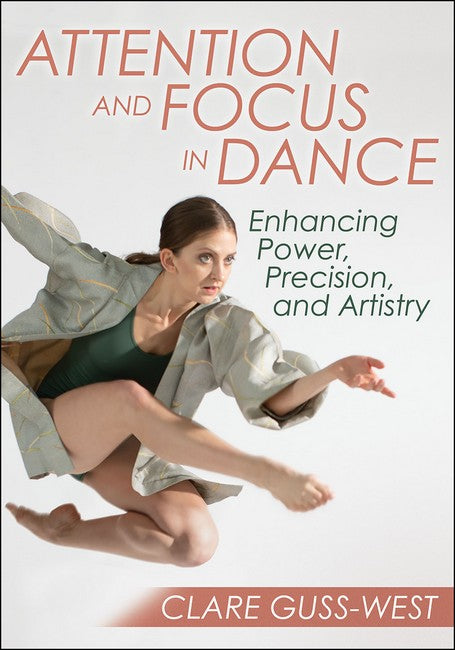Clare Guss-West is a former professional dancer, choreographer, holistic health practitioner and author specialising in the integration of holistic health and dance. Clare's innovative work translates recent scientific research findings on attentional focus for direct application in professional, vocational and inclusive dance practice. Supported by her Eastern-movement practice, she provides mindful attention and focus strategies that harness mind, energy and effort to empower dancers, giving them the edge and the tools to enhance their own physical and mental performance and achieve their best. She shares this work with the dancers, teachers and health care teams of such companies and educational organisations as Finnish National Ballet and School, The Royal Ballet, Houston Ballet, Ballet de L'Opera du Rhin, Opera de Paris-Opera Universite, Dutch National Ballet Education, Pole Superieur de Danse Rosella Hightower and the Nureyev Foundation as well as the Royal Academy of Dance (RAD) international CPD programme. To facilitate inclusive dance practice, Clare adapts attentional focus theories as effective teaching tools to enable movement, promote creativity and restore well-being. She employs this approach in her Danse Senior projects at Konzert Theater Bern Dance Company and teaches it on the MAS Dance Science, Bern University, the University Diploma, 'Dance, Health & Aging', University Cote d'Azur and in RAD's CPD module Dance for Adults and Older Learners. Trained as a classical and contemporary dancer and musician, Clare began choreographing with American composer Philip Glass and was resident choreographer and director at English National Opera. She has done productions for Lyric Opera of Chicago, Los Angeles Opera, Seattle Opera, San Francisco Opera and Ballet, Dutch National Opera and Ballet, Royal Opera House, BBC Proms and Opera de Paris. As cofounder and director of the Dance & Creative Wellness Foundation (launched with the support of Dutch National Ballet) and chair of the Dance for Health committee of the International Association for Dance Medicine & Science (IADMS), she is an international advocate of the well-being benefits of dance and its role in innovative preventative health.
Request Academic Copy
Please copy the ISBN for submitting review copy form
Description
Foreword: An Introduction to Attentional Focus Gabriele Wulf, PhD Recent scientific research findings: "An external focus of attention is key to optimal performance and learning." Part I. Shifting Attention Chapter 1. Attentional Focus Challenges of Dancers Explores the multitasking demands and information overload of dancers today and the need for a systematic attention and focus strategy in dance training and performance. Chapter 2. Attentional Focus: A Scientific Perspective Looks at how scientific attentional focus research relates to dance practice, translating attentional focus findings into dance vocabulary for practical dance contexts. Chapter 3. Attention and Focus: The Intersection of Eastern and Western Movement Investigates attention and focus in Eastern movement practice where it intersects with recent scientific findings to provide depth and alternative attentional tools for the dancer. Chapter 4. Attentional Focus: Enhancing Power, Precision and Artistry Revisits dance foundations with attention and focus techniques that renew meaning and develop energy, stamina and speed for specific dance challenges. Chapter 5. Refocus Mind, Replenish Energy Introduces remedial attention and focus techniques for performers and teachers to clear the mind and replenish energy in motion to protect from energy depletion and exhaustion. Part II. Cueing Attention Chapter 6. Teaching With External Attentional Focus Presents practical attentional strategies for teaching, self-coaching and optimal cueing from beginner skills to refining of movement with advanced and professional dancers. Chapter 7. Beyond Attentional Focus Places attentional focus in context to explore complementary holistic strategies that support the autonomy of the dancer to bring further benefits to learning and performance. Chapter 8. Optimal Attentional Cueing Refines the art of optimum self-cueing, teaching cueing and feedback to enable high performers' need for powerful, efficient movement at the service of an artistic intention.
"Clare Guss-West's holistic approach to classical ballet seems like an idea long overdue... Her approach offers ways to link the latest trends in choreographic innovation to the essence of traditional dance forms as energetic transformations of the spirit." Peter Lewton-President of International Association for Dance Medicine & Science (IADMS) "After using the Reflection Prompts from Chapter 2 and self-reflecting on how many external focus elements I use, I became so passionate that I gave a full class using only external focus. I was inspired to find new ways to guide dancers into what I want them to achieve." Javier Torres-International teacher, choreographer, and former professional dance "Clare is a very effective and enchanting educator. She offers elements to our practice that seem very ethereal yet are so practical; very elusive yet so easy. Enjoy discovering how less (but efficient) is sometimes more!" Astrid Sherman, FISTD-ISTD USA representative, former professional dancer, dance educator "I had the pleasure to come across the beautiful work of Clare Guss-West at the IADMS Conference, Seattle. The information and modalities that she has gathered to help with neural flexibility as well as assuring healthy and sensible physical engagement for dancers of all ages is presented in a open hearted and practical manner. One deceptively simple imaginary exercise introduced has proven to be an invigorating warm up in the ballet classroom. At IADMS Washington Conference she shared her insights into the way in which Qi Gong plays into dance. She has integrated her considerable understandings and skills in ways that the dancers can become more connected to their breath and increase their understanding of the origins of their movements." Stephanie Saland-Former professional dancer NYCB, Dance Educator

